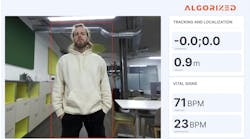Forming technology research takes many directions, and among the most dynamic areas of development is the ongoing progress in forming composite parts. Last fall, the National Composites Centre (NCC) at the University of Bristol in England started operating a new Schuler press for high-volume manufacturing of parts in carbon-fiber composite materials. The start-up coincided with NCC’s opening of its new facilities, which doubled the size of the center.
The NCC brings together industrial, academic, and government interests to develop design and manufacturing technologies for high-quality composite products. The upstroke, short-stroke press has a force of 36,000 kN and a clamping surface of 3.6 × 2.4 meters.
“We have installed the world’s largest openly accessible, high-rate manufacturing press for composites,” explained Tom Hitchings, the NCC business development director.
“This is aimed at supporting sectors such as automotive, where developing high rate, low-cost manufacture of composite components is critical. This press is producing parts within less than five minutes.”
The NCC prepares composite parts using the High-Pressure Resin Transfer Molding (HP-RTM) process, in which carbon-fiber material is placed in a die, filled with resin, and hardened by applying heat and the pressure of the press.
For complex shapes requiring high rigidity, HP-RTM presses achieve short cycle times, but they also maintain geometric accuracy and high surface quality. In the process, the resin is injected quickly into the vacuum mold, which is opened less than a millimeter, but enough for the resin to spread over the material with very little flow resistance (thus, low injection pressure). The resin infiltrates the material via induction heating before polymerization begins.
The vacuum assistance, fast resin injection, high resin pressures, and tempered dies mean that the gelling begins with the wetting of the last fiber. Thicker parts take longer to cure and depending on the part, the necessary resin pressures also vary between 60 and 150 bar.
Due to the geometry of the part or cavity surface, the die’s center of loading is not necessarily in the middle of the press. Also, there are off-center forces from the injection positions. The parallelism control prevents the slide or upper die from tilting during gap injection, to promote smooth and even injection over the entire surface.
Conventional downstroke machines work with a fixed bed and moving bolster, and a slide that transmits press force via cylinders in the press crown. Four servo-controlled, counter-pressure cylinders located at the bed corners ensure parallelism. These also are responsible for the force needed to counter the adhesive forces and open the die.
In the upstroke short-stroke press, the slide alone acts as support during the pressing process. From the top dead center, the slide is moved by a drive cylinder to its support position, and locked there. The actual working stroke is performed by the bedplate, driven by several short-stroke, servo-controlled cylinders that maintain parallelism.
The breakout force in upstroke presses is achieved by withdrawing the bedplate. The benefits of the upstroke short-stroke press (compared to a downstroke design) is the high closing speeds (1,000 mm/sec), the shorter pressure build-up times of under 0.3 sec., and the significantly lower height of the installation.
“The Centre now has something for all businesses involved in composites manufacture, across all sectors,” Hitchings added.
“Our open-access model provides a flexible approach to enable working with companies of all sizes—from SMEs to Tier 1s and large OEMs. We already have commitments from large and medium-sized enterprises involved in renewable energy, aerospace, automotive, defense, marine, and rail, and we expect this list to grow. With the addition of the new Schuler press, the NCC becomes a catalyst for real change in the industry.”









